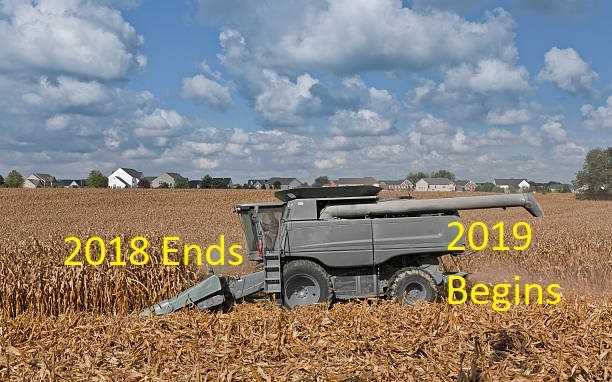About Your Fields, August 20, 2018
In this issue:
1. Decision Time
2. DAP vs MAP
3. What's Next?
Decision Time 2019
As we come to the end of August summer is ending and we need to start looking at fall, and the harvest that comes during that time of the year. Just as we did in the late winter and early spring the focus of the next few newsletters will be on some of the basic products that you will need to get started on next year's crop. This is a very obvious time when the 2018 crop ends and the 2019 crop starts depicted in the picture below.

As soon as the combine passes through the field and the grain is separated from the plant every decision that is made from the middle of the combine on will have an effect on the next year's crop. How you manage your residue, your tillage practices and what type and amount of fertilizer you apply will start impacting your next crop. This week we will start to focus on phosphorus, the different forms, where it comes from and how you can apply it to maximize your crop's potential.
DAP vs MAP
Phosphorus is a key element in today's crop production systems, both in corn and soybeans. In the past we focused on how phosphorus works in corn, but recently there has been more research on how it will affect the soybean crop as well. So where do we start? Let's look at where phosphorus comes from and how we can apply it to your fields.
Practically all inorganic phosphate fertilizers come from rock phosphate that is mined. The rock phosphate is then mixed with sulfuric acid to form phosphoric acid. Phosphoric acid is then mixed with ammonia to produce phosphate fertilizers such as monoammonium phosphate (MAP) and diammonium phosphate (DAP).
What is the difference between MAP and DAP? Not much, the main difference is in the amount of phosphorus that you can get in a ton of each the products. MAP's typical analysis is 11-52-0 and DAP is typically 18-46-0. What this means is that MAP is 11% nitrogen and 52% phosphorus and DAP is 18% nitrogen and 46 % phosphorus. So, in a ton of MAP you will get 220 units of nitrogen and 1,040 units of phosphorus. In a ton of DAP, you will get 360 units of nitrogen and 920 units of phosphorus. The increased nitrogen and decreased phosphorus in DAP are a result of the refining process. The difference in overall phosphorus availability to the plant is negligible (as shown in the following chart) as both start out as P2O5 and need to convert to a more plant available form of phosphorus to be utilized.

So, you may ask why choose one product over the other? My simple answer would be cost per unit of P, but there is more to consider when deciding. First off are you going to credit the nitrogen that you are getting from the fertilizer. If you are then you need to consider how much the extra N would cost you if you substituted the loss of N from MAP to DAP. If you are spreading in front of soybeans is the added N necessary? I don't feel that it is necessary to have the additional N in front of soybeans. Soybeans make the majority of their own N so adding additional N does not get you your biggest bang for your dollars spent. If you are planting corn then the additional N could help, but it depends on what the price for N is in other types of fertilizer.
Lets wrap it up with a quick refresher on phosporus in the crops. A soil test with a P level of 50 to 70 is considered optimum, with some tests saying that a value of 90 is excessive. The key is to make sure you have an adequate supply of P that is available when the plant needs it throughout the season. If you look at the pictures below you will see that both corn and soybeans need phosphorus late in the season. But as we have discussed in earlier newsletters P is crucial in the corn plant before V5 to help set ear length and girth. If you do not have adequate levels of P you will need to use a starter fertilizer to provide this small amount needed to get the corn plant started off right. Feel free to discuss your options for phosphorus fertilizer with any of the agronomists at Akron.


What's Next?
If you are going to apply phosphorus fertilizer shouldn't you make sure that it is in the most available form when the plant needs it? If you want to maximize yields then you need to protect your phosphorus from getting tied up in the soil. One way to do this is use a product called Avail T5 from Verdesian. This is a new formulation of Avail that improves the protection required in our higher CEC soils that we have here. Phosphorus molecules can get tied up by positively charged elements like calcium, aluminum and iron. Avail T5 has more binding sites and it will shield your P from getting tied up. If you have questions about Avail T5 speak with one of Akron's agronomists or come to our Agronomy Day on September 4th and speak with the Verdesian rep in person.